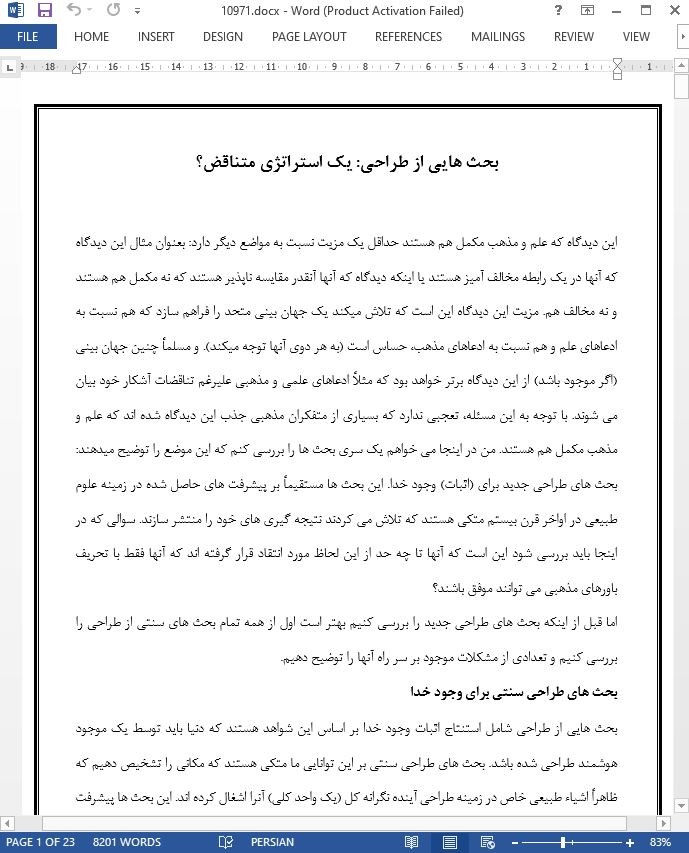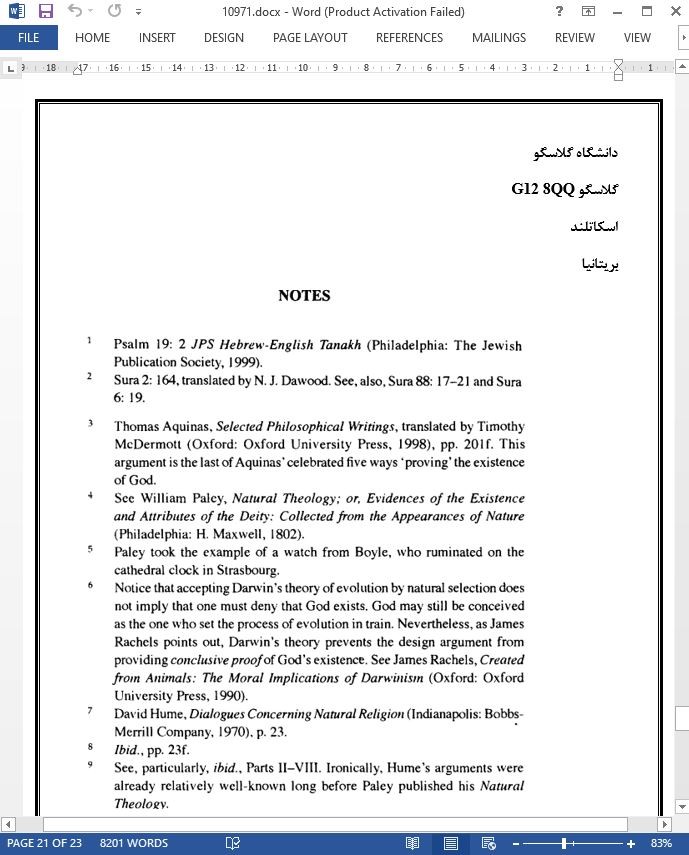
بحث هایی از طراحی: یک استراتژی متناقض؟
این دیدگاه که علم و مذهب مکمل هم هستند حداقل یک مزیت نسبت به مواضع دیگر دارد: بعنوان مثال این دیدگاه که آنها در یک رابطه مخالف آمیز هستند یا اینکه دیدگاه که آنها آنقدر مقایسه ناپذیر هستند که نه مکمل هم هستند و نه مخالف هم. مزیت این دیدگاه این است که تلاش میکند یک جهان بینی متحد را فراهم سازد که هم نسبت به ادعاهای علم و هم نسبت به ادعاهای مذهب، حساس است (به هر دوی آنها توجه میکند). و مسلماً چنین جهان بینی (اگر موجود باشد) از این دیدگاه برتر خواهد بود که مثلاً ادعاهای علمی و مذهبی علیرغم تناقضات آشکار خود بیان می شوند. با توجه به این مسئله، تعجبی ندارد که بسیاری از متفکران مذهبی جذب این دیدگاه شده اند که علم و مذهب مکمل هم هستند. من در اینجا می خواهم یک سری بحث ها را بررسی کنم که این موضع را توضیح میدهند: بحث های طراحی جدید برای (اثبات) وجود خدا. این بحث ها مستقیماً بر پیشرفت های حاصل شده در زمینه علوم طبیعی در اواخر قرن بیستم متکی هستند که تلاش می کردند نتیجه گیری های خود را منتشر سازند. سوالی که در اینجا باید بررسی شود این است که آنها تا چه حد از این لحاظ مورد انتقاد قرار گرفته اند که آنها فقط با تحریف باورهای مذهبی می توانند موفق باشند؟
اما قبل از اینکه بحث های طراحی جدید را بررسی کنیم بهتر است اول از همه تمام بحث های سنتی از طراحی را بررسی کنیم و تعدادی از مشکلات موجود بر سر راه آنها را توضیح دهیم.
بحث های طراحی سنتی برای وجود خدا
بحث هایی از طراحی شامل استنتاج اثبات وجود خدا بر اساس این شواهد هستند که دنیا باید توسط یک موجود هوشمند طراحی شده باشد. بحث های طراحی سنتی بر این توانایی ما متکی هستند که مکانی را تشخیص دهیم که ظاهراً اشیاء طبیعی خاص در زمینه طراحی آینده نگرانه کل (یک واحد کلی) آنرا اشغال کرده اند. این بحث ها پیشرفت هایی از این ایده هستند که در کتب آسمانی هر یک از ادیان ابراهیمی دیده میشود. بعنوان مثال در کتب آسمانی عبری می خوانیم که: کهکشان ها نشانه ای از جلال خدا هستند، و آسمان یک اثر ساخته شده دست او است . در قرآن نیز آمده است:
در خلق آسمان ها و زمینآمد و شد شب و روز، و کشتی هایی که با محموله های سودمند برای انسان ها در اقیانوس ها شناور هستند، در آب هایی که الله از آسمان نازل کرده است و زمین را بعد از مرگش با آن زنده می سازد، و انواع جنبندگان را در آن پراکنده کره و در تغییر مسیر بادها و ابرهایی که در میان زمین و آسمانها مسخرند؛ بی گمان نشانه هایی است برای انسان هایی که می اندیشند .
The view that science and religion are complementar 3, has at least one significant advantage over other positions, such as the view that they are in an antagonistic relationship or the view that they are so incommensurable that they are neither complementary" nor antagonistic. The advantage is that it aspires to provide a unified worldview that is sensitive to the claims of both science and religion. And surely, such a worldview, if available, would seem to be superior to one in which, say, scientific and religious claims were held despite their obvious contradictions. Given this, it should come as no surprise that many religious thinkers have been attracted to the view that science and religion are complementar3,. Here, I wish to consider a cluster of arguments exemplifying this position: namely, 'new design arguments' for the existence of God. These arguments rely directly on developments in late twentieth-century natural science in attempting to establish their conclusions. One question that will need to be addressed is: To what extent are they susceptible to the criticism that they only succeed by distorting the religious beliefs they claim to champion?
But before we examine new design arguments, it would be wise to consider first of all the traditional arguments from design, and note some of the problems they have faced.
Traditional Design Arguments for the Existence of God
Arguments from design consist in deducing the existence of God on the basis of evidence that the world must have been designed by an intelligent being. Traditional design arguments rely upon our ability to recognise the place that particular natural objects purportedly occupy within the context of the providential design of the whole. Such arguments are developments of an idea that appears in the scriptures of each of the Abrahamic faiths. In the Hebrew Scriptures, for example, one reads: 'The heavens declare the glory of God, the sky proclaims His handiwork') Likewise, the Qur'an proclaims:
In the creation of the heavens and the earth; in the alternation of night and day; in the ships that sail the ocean with cargoes beneficial to man; in the waters which Allah sends down from the sky and with which He revives the dead earth, dispersing over it all manner of beasts; in the movements of the winds, and in the clouds that arc driven between earth and sky: surely in these there are signs for rational men3
بحث های طراحی سنتی برای وجود خدا
بحث های طراحی جدید
انتقاداتی از بحث های طراحی جدید
Traditional Design Arguments for the Existence of God
New Design Arguments
Some Criticisms of New Design Arguments
- اصل مقاله انگلیسی با فرمت ورد (word) با قابلیت ویرایش
- ترجمه فارسی مقاله با فرمت ورد (word) با قابلیت ویرایش، بدون آرم سایت ای ترجمه
- ترجمه فارسی مقاله با فرمت pdf، بدون آرم سایت ای ترجمه


